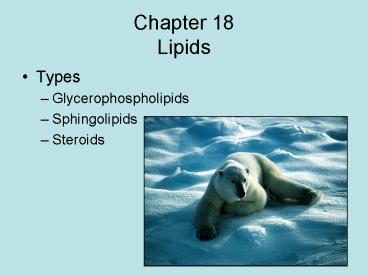Chapter 18 Lipids - PowerPoint PPT Presentation
1 / 32
Title:
Chapter 18 Lipids
Description:
The structural formulas of these types of lipids illustrate the great structural ... hydrogenation of a triacylglycerol with oleic acid and fatty acid residue. ... – PowerPoint PPT presentation
Number of Views:116
Avg rating:3.0/5.0
Title: Chapter 18 Lipids
1
Chapter 18Lipids
- Types
- Glycerophospholipids
- Sphingolipids
- Steroids
2
Lipids contd
- Fig. 19.1
- The structural formulas of these types of lipids
illustrate the great structural diversity among
lipids.
3
Glycerol 3 FA TAG
Glycerol
Fatty acid (FA)
Triacylglycerol (TAG)
Q. What kind of bonds are these?
A. ESTER!
4
Lipids contd
- Fig. 19.5
- Structure of the simple triacyglycerol produced
from the triple esterification reaction between
glycerol and three molecules of stearic acid.
5
Fatty Acids can be
saturated
monounsaturated
polyunsaturated
Unsaturated, trans or cis-
6
Lipids contd
- Fig. 19.6
- Mixed triacylglycerol in which three different
fatty acid residues are present.
7
Physical Properties
- Solid fat
- Liquid oil
- Long ether/alcohol wax
- Melting points depend on length, degree of
saturation, orientation of double bond (cis or
trans)
8
Lipids contd
- Fig. 19.8
- Percentages of saturated, monosaturated, and
polyunsaturated fatty acids.
9
(No Transcript)
10
Chemical Properties
- Reduction (hydrogenation) of unsaturated fatty
acids - Removal of double bond
- Oxidation
- Unsaturated FA to aldehyde to carboxylic acid
- Hydrolysis (breaking of ester bond by water
- Q. Products?
- A. Alcohol and carboxylic acid
11
Lipids contd
- Fig. 19.10
- Complete and partial hydrolysis of a
triacylglycerol.
12
Lipids contd
- CC 19.3
13
Lipids contd
- Fig. 19.11
- Structural equation for the complete
hydrogenation of a triacylglycerol with oleic
acid and fatty acid residue.
14
Prostaglandins
Arachodonic acid (20 carbons)
Aspirin, NSAIDs
Prostaglandin
15
Glycerophospholipids
Phosphoglycerol
Phosphatidic Acid
Headgroups
serine
ethanolamine
choline
16
Lipids contd
- Fig. 19.13
- (a) structural formula and (b) molecular model
showing the head and two tails structure of a
phosphatidyl-choline molecule.
17
Lipids contd
- CC 19.4
18
Glycerophospholipids
Phosphatidylcholine (lecithin)
Polar
Non-polar
19
Sphingolipids
Sphingosine
20
Lipids contd
21
Sphingosine
fatty acid (R saturated)
Ceramide
22
Ceramide
phosphocholine
sphingomyelin
23
Glycosphingolipids
Sugar (galactose)
cerebroside
Ganglioside (GM2)
Lipid Storage Diseases Accumulation of
glycosphingolipids Fabrys Tay Sachs Gauchers Nie
man-Pick
24
Steroids
Cholesterol
Sterol nucleus
Fatty acid
Cholesteryl ester
25
Steroid Hormones
Testosterone
Estrogen (estradiol)
Progesterone
Norethindrone The Pill
26
Lipids contd
- Table 19.4
27
Cholesterol TransportLipoproteins
28
(No Transcript)
29
The Membrane The Fluid Mosaic Model
30
(No Transcript)
31
Membrane Transport
- Simple Diffusion (Small molecules)
- High concentration to low concentration
- (With concentration gradient)
- Facilitated Transport
- Small ions through pores or channels (proteins)
- (With concentration gradient)
- Active Transport
- Energy-requiring (ATP)
- (Against concentration gradient)
32
(No Transcript)































